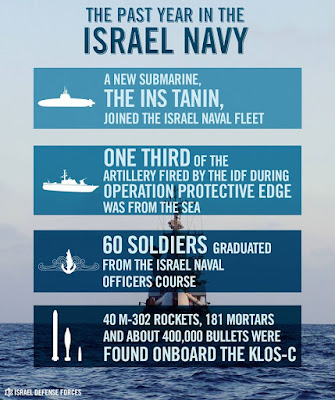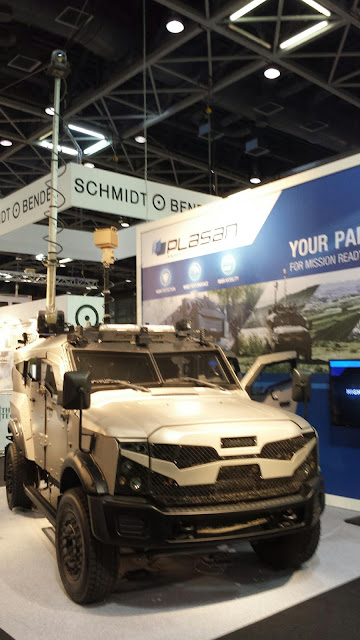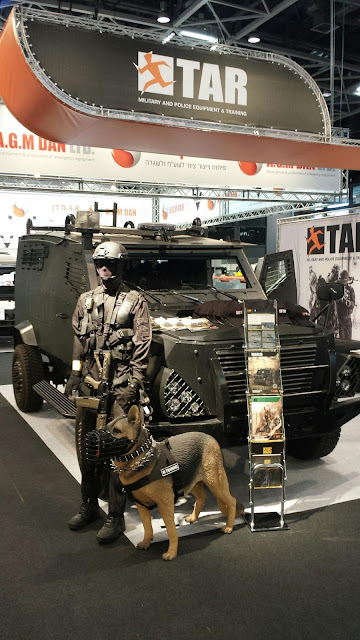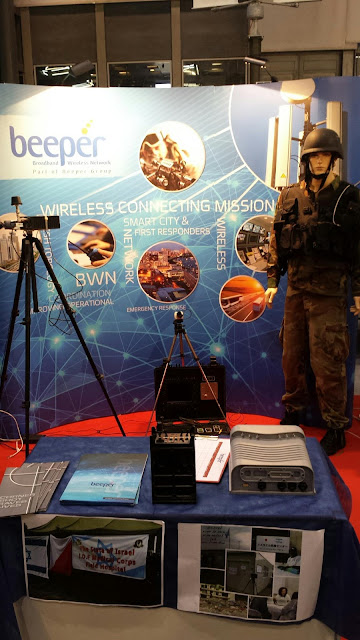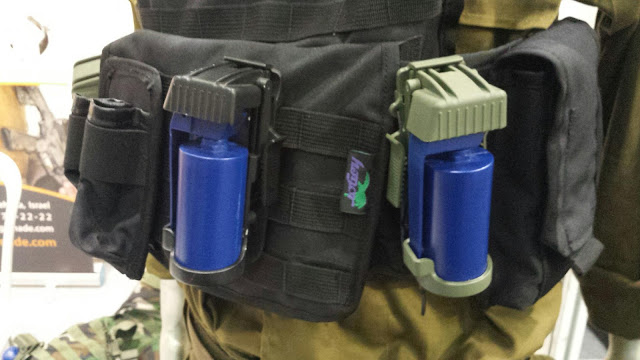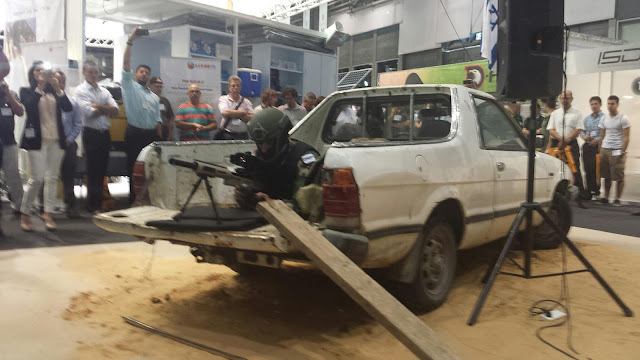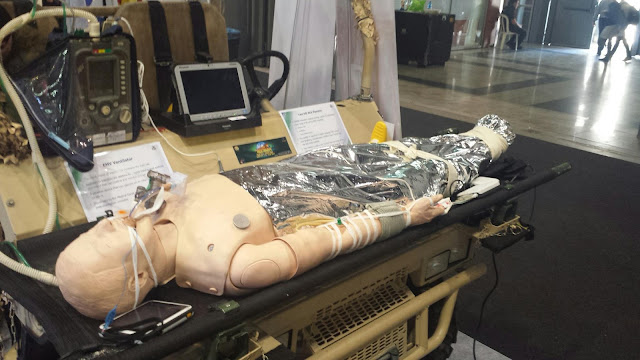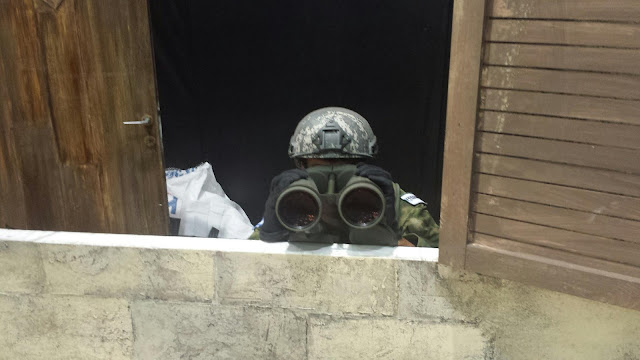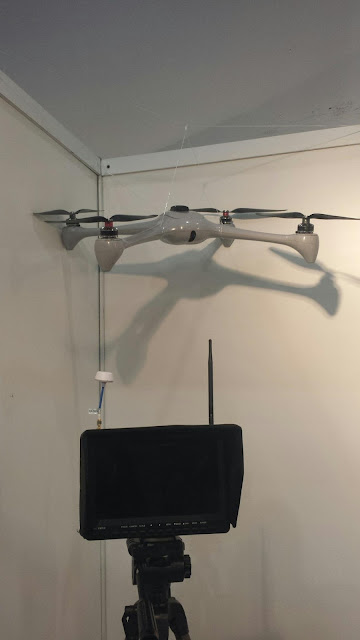Innovative military technologies are crucial for Israel's ability to survive and thrive. The protracted strain on relations between Israel and its neighbours has created an unexpected level of success for the young nation: One of the world's top defence industries that uniquely offers combat-proven performance.
![]() |
| The IDF differ from most Armed Forces in the world in many ways, with close relations between the Ground Forces, Air Force and Navy, including a mixed-gender infantry unit. (Photo: IDF) |
Israel provides key capabilities, across the spectrum of conflict. The nature and duration of Israel’s domestic and external security challenges has created a strong, indigenous independent defence sector unusually well adapted to meeting the needs of conventional military forces against peer competitors, as well as those of homeland security without creating an artificial barrier between the two. Equally the modest domestic defence budget has, from the very start obliged those same companies to address international markets as a priority in order to ensure their commercial survival.
Since its inception, the IDF continually strives to be a successful military service fitting Israel's unique national requirement - survival. This could not happen without the help of the Israeli defence industry, which is divided into state owned and publicly- and privately-held companies. Israel produces an enormous range of products, ranging from ammunition, small arms and artillery pieces to sophisticated electronic systems, communication, and unmanned vehicle systems.
Having the disadvantage of fighting wars in its own territory – and on a 360° front, Israel built the IDF and furnished it with an arsenal of highly-advanced military hardware.
Israel invests more money in research than most other countries, as research institutes, the defence industry, the military, and politics are interwoven, resulting in a high-tech defence factory that successfully exports its goods globally.
An example for state and industy is
Israel Military Industries (
IMI), which will be sold as one entity but, in accordance with cabinet decisions, and a new state-owned company to be called
Tomer Systems will maintain the secret and classified elements of the firm. IMI will have to move to Ramat Baka in the Negev to free up prime real estate starting in 2020. In preparation for the privatisation, the state let go some 1,170 employees (with early retirement packages), while another 950 will be let go as part of the privatisation, in accordance with collective labour agreements. The state expects to complete the sale by the end of 2015. The sale will be open to Israeli companies or Israel- based companies, but also to foreigners that hold at least a 90% stake in an Israeli company.
![]() |
| Israel Weapon industries (IWI) UZI PRO and ACE. (Photo: IWI) |
Innovative Technology from the Far East
At Eurosatory 2014,
Commtact, a leader in advanced wireless communication solutions for military and civilian applications, launched a line of tactical multi-band UHF/VHF radios, and displayed its Advanced Mini Link System (AMLS) with a new algorithm suitable for UGVs. The new line of tactical broadband UHF/VHF (UVR) radios is based on an advanced analog/digital system with open architecture that enables handling large amounts of both audio and data/Ethernet transmissions. The system - consisting of building blocks - is modular, versatile and suitable for a variety of applications on land, sea and air. The solution is made up of a multi-band, multi-mode transceiver, providing the platform with clear, secure voice and data communications facilities over an extended frequency range. The UVR family provides a wide range of functional options to meet diversified operational requirements including ATC UHF radio.“
We are pleased to launch our new UVR solution, which is a natural direction for the company,”
Sharon Shlomo, VP Marketing of Commtact told MT. “
The UVR development was based on the experience and know-how gained by Commtact over many years of activity in the field of airborne radio communications. The systems have been sold and deployed by a number of customers around the world, and we are already seeing interest expressed by additional customers. The system will be displayed at our stand during the exhibition, and we invite everyone to visit us and learn more about our solutions.”
Controp specialises in the development and production of EO and Precision Motion Control Systems. The company’s specialists have over 35 years of experience in EO/IR products for surveillance, defence and homeland security. Controp’s main product lines include: Automatic passive Intruder Detection Systems for airport perimeter surveillance, coastal surveillance, port and harbour security, border surveillance, the security of sensitive sites and ground troops security; high performance Stabilised Observation Payloads used for day and night surveillance on board UAVs, small UAVs and aerostats/balloons, helicopters, light aircraft, maritime patrol boats and ground vehicles; thermal imaging cameras with high performance continuous zoom Lens and state-of-the-art image enhancement features, and more. Controp’s products are in daily operational use in many of the most critical surveillance, homeland security and defence programmes worldwide. At Aero India 2015, in addition to the new MICRO-STAMP (story elsewhere in this magazine), Controp demonstrated its M-STAMP lightweight gyro-stabilised Multi Sensor Payload for small UAVs and small aircraft. Weighing only 1.3kg, the M-STAMP has a CCD with Continuous Zoom Lens, Uncooled IR Camera with state-of-the-art Continuous Zoom Lens and Laser Pointer.
![]() |
| CONTROP Precision Technologies, a world leader in EO/IR- and homeland security solutions, at this year's GSA Global Security Asia 2015 showcased its recent technological breakthrough: The new 3D-GUARD – Advanced 3 Dimensional Video Motion Detection System, designed for the protection of borders, strategic facilities and perimeters. 3D-GUARD is a day/night system for 24/7 automatic detection and alert of moving targets/intruders. (Photo: Controp) |
In January, Israel's MoD has awarded
Elbit Systems rights to develop the next generation of the Israeli Army's digital C4I network under a series of multiyear contracts estimated at $117 million.
Under the contracts, Elbit Systems, developers of the Israeli Army's operational network known as TZAYAD (Digital Army Programme), will develop what it described as a master programme that computerises all operations in the land forces, connecting all field and command echelons into a central data transfer network. The project is part of the IDF's plan to support advanced, interoperable communications systems through the smart transfer of huge amounts of bandwidth. Furthermore, the company will upgrade, maintain, supply, and support communications systems and wideband radio systems on behalf of the Israeli military under a private financing initiative outsourcing deal with MoD.
Gilat Satellite Networks work on providing integrated end-to-end C4I solutions using VSATs operating using the DVB-S2 and DVB-RCS standard optimised for military use and necessary features. The firm’s solutions include low profile on the move solutions as well as MANPACK, Flyaway and On The Halt solutions with products such as the dual axis S-200 low profile antenna which support throughput of 1Mbps.
Today's wide-area surveillance missions require a powerful combination of UAS with sophisticated airborne elements and capabilities. To meet the growing demand for such highly advanced applications,
Israel Aerospace Industries (
IAI) has integrated
Rafael's RECCE-U payload into the HERON UAV. This new configuration created a breakthrough, according to the company, as operational capabilities, traditionally perceived as a mission for fighter aircraft only, can now be performed by HERON, including wide-area scanning and mapping, automatic change-detection and motion-detection. RECCE-U is an advanced airborne reconnaissance payload, based on Rafael's RECCELITE payload, in operational use by leading Air Forces in different parts of the world.
RECCE-U is considered to be one of the world's most advanced real-time Wide-Area Surveillance Systems. The combination of HERON's mission versatility, reliability and long endurance, together with RECCE-U's multi-role intelligence capabilities provides a cutting-edge solution for total area dominance. The new HERON configuration allows persistent, high-quality intelligence gathering, transferred in real time through wide-band communication to the ground exploitation and control station for analysis and decision making. This includes updated mission plans uplinked in real-time, automatic GES processing for speedy image interpretation, and advanced GES change detection software for IED detection. Accomplished by highly autonomous technology, the process requires only a minimal operating crew.
![]() |
| “IAI is concluding 2014 as Israel's largest hi-tech and defence company with record sales of nearly U$4 billion to the defence and commercial markets,” Rafi Maor, Chairman of the IAI Board stated. “We are displaying improvement in all the profit parameters, despite the significant decrease in net income, which mainly results from recording deferred tax expenses due to the increase in the US dollar exchange rate. It is important to note that although in the short term the net income has been affected by recording tax expenses for accounting purposes, the increase in the US dollar exchange rate means positive news for IAI in the future, given that the company focuses mainly on exports with 80% of sales going to global markets. The diversity of its operations allows IAI to offer its customers comprehensive, wide system solutions and efficiently cope with the challenges in the different segments. The company is simultaneously continuing to examine the different issues involving the preparations for an IPO of minority shares.” (Photo: IAI) |
![]() |
| Concluding 2014 with an order backlog at a scope of approximately $9.2 billion, representing 2.3 years of operation, Joseph Weiss, IAI President & CEO explained that, “in addition to this major volume of transactions, IAI has been performing intense marketing activities for a variety of products and systems to numerous and diverse customers worldwide, which we believe will bear significant fruits in 2015. The company has also taken steps in identifying and focusing on several major growth engines for the coming years. For example, the area of UAS continues to represent a central growth engine and this year we have also entered new and innovative areas in this segment. The air defence and mission aircraft fields have reached major achievements in 2014 which cannot be elaborated upon for security reasons. We estimate that these fields will continue to represent a significant growth engine at the technological front.” (Photo: IAI) |
IAI also invests resources and focuses on the conversion of defence technologies to commercial markets in order to leverage the vast knowhow and huge accomplishments in the defence market. IAI also sees a great deal of potential in its cyber activities that are designed for both the defence and the commercial markets. This year, the company has conducted major transactions in its target markets based on its innovative and idiosyncratic capabilities in the cyber field.
![]() |
| Rafael’s MATADOR (RGW-90) AS incorporates an advanced tandem warhead concept that makes it highly effective against structures, fortified positions, and light armour vehicles. It can operate in two modes: Emplacement against structures and fortified positions and mouse holing against walls and light armour vehicles. (Photo: Rafael) |
In 2014,
Rafael continued its efforts to expand existing markets and enter developing markets, while creating new local partnerships. During the year, Rafael signed a joint-venture agreement with
Bharat Forge of India, aimed at strengthening the sales potential in the important Indian market. In addition, the year 2014 was characterised by Rafael’s continued investment and professional development of its human capital, while maintaining its R&D (8% of its sales), in the professional development of its employees, and its significant cooperation with academic institutions.
VAdm. (ret.) Yedidia Yaari, President and CEO of Rafael, said that in 2014 Rafael's contribution to Israel's security was well-witnessed during Operation “Protective Edge,” with IRON DOME's high interception rates of some 90%, as well as the central role of other Rafael technologies, including its SPIKE family missiles, the TROPHY APS for MBTs, and other system that acted as force multipliers with the IDF. This was supported by round-the-clock work by many of Rafael's scientists, engineers and technicians. At the same time the company continued its marketing efforts as well as expansion of its global partnerships. Yaari added that the company's human resource is at the forefront of its ability to deliver some of the most advanced technologies to the IDF and to customers around the world, thereby enabling Rafael's continued growth both in Israel and globally.
Brig.Gen. (ret.) Itzhak Gat, Chairman of the Board at Rafael, said that Rafael continues to be a main pillar in Israel's security, economy and society, thanks to Rafael's managers and employees and managers.
![]() |
| Rafael continues to offer its customers and partners a wide variety of advanced solutions and systems for specific needs and requirements. Many of these have already proven themselves in combat. In 2014 we increased our activity in the fields of intelligence and Cyber warfare, as well as homeland security and strategic asset and infrastructure protection,”, VAdm. (ret.) Yedidia Yaari, President and CEO of Rafael said. (Photo: Rafael) |
![]() |
| "Our technological and financial resilience and robustness enable us to make substantial investment in two significant fields: Nurturing our human capital and investing in R&D,” Brig.Gen. (ret.) Itzhak Gat, Chairman of the Board at Rafael explained. “This will ensure the next generations of advanced defense systems that will secure Israel's military supremacy in the air, on land and at sea. Such capabilities, developed by Rafael's employees enable the IDF to achieve successful operation capabilities such as the ones we witnessed during Operation ‘Protective Edge.’ The realisation of Rafael's potential in the international markets is a central component in the company's growth path. This will allow us to continue to invest substantial resources in R&D." (Photo: Rafael) |
Elbit Systems recently reported its consolidated results for the fourth quarter and full year ended 31 December 2014. Revenues for the year were $2,958.2 million, as compared to $2,925.2 million in 2013. The leading contributors to Elbit Systems’ revenues were the airborne systems and C4ISR systems areas of operations. The increases in the airborne systems and C4ISR systems areas of operation were primarily due to increased revenues from airborne EW systems worldwide and HLS systems sold to Latin America. Revenues from land systems in Israel and electro-optic systems in the US decreased slightly. On a geographic basis, the increase in revenues in Asia-Pacific was mainly due to increased sales of a project to upgrade tanks for a customer in this region. The strong growth of revenues in Latin America was mainly due to increased sales of HLS and EW systems as well as unmanned airborne systems in this region.
![]() |
| We are pleased with our performance for the fourth quarter and the full year for 2014, which indicates a solid business base,” Bezhalel (Butzi) Machlis, President and CEO of Elbit Systems, commented. "We are encouraged by the growth in our backlog over the past year which, as expected, led to an increase in revenues. This is an indication of our growth potential, while providing us with good visibility into the coming years. Another important element of our results is the solid growth in two important target regions for us, Latin America and Asia-Pacific. These results, combined with a somewhat more favorable macro-environment for defense spending, lead us to be optimistic with regard to 2015." |
On 4 January 2015, the company announced that it was awarded an approximately $90 million contract from the Israeli MoD (IMOD) for the maintenance of the Israeli Air Force's F-16 array’s avionics systems. A day later, the company was awarded an approximately $100 million contract from the MoD to procure six new firefighting aircraft and operate the firefighting squadron, which will consist of a total of 14 aircraft, including eight aircraft previously procured by Elbit Systems. On 14 January, the company was awarded contracts in a total amount of approximately $54 million by the MoD, for the supply and maintenance of advanced EO systems, and another day later another contract in a total amount of approximately $117 million, for the supply of C4I systems and communications systems. On 19 January, Elbit Systems was awarded a contract from an Asian Army to provide the mini MUSIC™ IR MWS based DIRCM systems for the customer’s BLACK HAWK helicopters.
An undisclosed MoD has selected
RADA Electronic Industries’ high-performance Multi-Mission Hemispheric Radar (MHR, an S-Band, Software-Defined, Pulse-Doppler, AESA radar) -based tactical radars for the country’s national alert system. Deliveries are expected to be completed during 2015. The has contributed to border protection during Operation “Protective Edge” on the Israel-Gaza border, making it the operational debut of the system. RADA offers advanced Pulse-Doppler, multi-mission, AESA radars for tactical applications. The company's INS solutions provide some of the best value solutions for aerial and land tactical vehicles. RADA is a leading provider in the field of airborne video and data recorders, and complete avionic upgrade suits for combat and ISR aircraft.
In space,
ImageSat International is a global provider of advanced, integrated, remote sensing based solutions. The company is the owner and operator of the EROS-A and EROS-B high/very high resolution earth observation optical satellites. A wide variety of services is offered by the company, utilising the EROS satellites high quality imagery and other sources of data. These services include: Satellite-based imaging: Rapid tasking and archive imagery; integration of imaging sensors; interpretation and analysis of imagery; photogrammetry and mapping; training in geospatial intelligence topics; and rstablishment of imaging satellites ground stations. Throughout 17 years of activity, since it was established in 1997, the company has gained extensive operational experience in the fields of defense and intelligence, maritime surveillance, oil and gas, urban development, environmental monitoring, agriculture and forestry, disaster control and others.
Ground Forces
Ground forces can bring in weapon effects, inorganic to their unit with advanced designation systems with solution such as
Elbit Systems’ Portable Light Weight Laser Designation system and RATTLER G hand held designator market.
IAI’s Ground Target Acquisition and Designation System provides a tripod mounted stabilised system, which combines an EO payload with a laser pointer, laser range finder and laser designation.
Overcoming the limitation of Line of Sight is
Camero’s XAVER range of sensors designed to see through walls and provide 3D imaging of targets behind walls with tits XAVER 800 portable device and the more compact XAVER 400 and 100.
![]() |
| The Camero XAVER 800 is a portable, high performance imaging system, optimised for gathering instant and accurate real-time information from behind solid walls or barriers, providing a true 3D imaging of objects behind walls. (Photo: Camero) |
Carmor, a public company formerly called
Hatehof, recently was awarded a contract for the design, manufacture and supply of armoured vehicles for approx. U$26 million, to be completed during 2015.
ESC BAZ offers a range of turn-key systems, has implemented wired, wireless and man-portable observation systems for in man-portable configurations, and in fixed and mobile solutions is often linked to border security tasks.
IAI have a range of radar technologies for the ground domain. These include the solid state AESA ELM-2180 Watch Guard Multi-Mode Ground Surveillance Radar using up to four non-rotating antenna each covering a 90° arc, the ELM-2112 (V10).
One of
Meprolight’s addition to their range includes the MEPRO M5, a compact and lightweight red-dot sight weighing less than 300g, specifically optimised for “both eyes open” shooting. The company has reported repeat orders from customers for other product lines – the NOA and NOA NYX Uncooled Thermal Weapon Sights,and MEPRO MOR, a Multi-Purpose Reflex Sights. In 2014, the company strengthened its position in the area of night vision with the purchase of
New Noga Light’s operations and assets. At Eurosatory 2014, Meprolight introduced the new MEPRO LRF 20-70 - a compact, very fast, Erbium Glass Technology-based Laser Range Finder with a range of 20,000m and a repetition rate of 1pps and 3pps in burst mode. The company also displayed the MEPRO LRF 15-02 - a new LRF configuration with an APD receiver that enables a significant extension of the range up to 10,000m, while still remaining lightweight and compact and keeping the same size.
![]() |
| Israel Weapon industries’ (IWI) bolt-action DAN .338 Lapua Magnum long-range rifle, developed in close collaboration with IDF snipers, with Meprolight’s MEPRO MESLAS, a compact, lightweight, programmable, multi-function, fire-controlled sniper’s riflescope 10×40 system that incorporates a single-pulse laser range finder operating in an eye-safe spectral range (invisible to night vision devices), a sniper’s telescope, and a fire-control computer. When measuring distance, it automatically calculates the elevation angle according to the ranged target accurate adjustability. The robust system withstands all environmental conditions as well as shocks and vibrations, and offers optional measurements of temperature, humidity, and axis angle sensor for ballistic calculations. (Photo: Meprolight) |
In 2015, Meprolight launched two new families of Tritium night sights for pistols. The MEPRO FT family of Fibre and Tritium, and the new MEPRO R4E series of Tritium night sights. The Fibre and Tritium combination enables an extremely bright aiming point in any light conditions, day or night. The new sights have a single dot at the rear sight, allowing extremely rapid and intuitive target acquisition. Developed through close and comprehensive collaboration with leading police units (SWAT, CRT), Israeli Special Forces, and shooting instructors from all over the globe, MEPRO FT sights are a cost-effective, intuitive and low-profile aiming solution that facilitates quick, instinctive, and accurate shooting. Designed by Special Forces veterans, the MEPRO R4E sights are designed for a clearer sight picture and faster shots. They have multiple horizontal and vertical alignment lines that enable exceptionally quick target acquisition. The series also features angle facets on the rear sight to allow the shooter greater target visibility while maintaining sight alignment.
Amir Karo, Director of Sales and Marketing said to MT: "
We are pleased to introduce two new families of sights for pistols. These families have been added to our extensive portfolio of Tritium-based night sights in order to provide additional capabilities for accurate nighttime pistol shooting, without the need for additional devices. We continue to expand our product lines in order to meet the needs of our customers."
Netline is at the forefront in the global war on terrorism working closely with leading military forces and government agencies, offering a wide range of electronic warfare, jamming, interception and detection systems, used on a daily basis in conflict zones around the world. Netline defence solutions are operationally proven and rapidly. Netline electronic countermeasures and spectrum dominance solutions for land, marine and airborne platforms protect personnel and equipment in conflict zones and target hostiles in the war against terror, insurgency, drugs, and crime.
Nimda’s main business is development and manufacturing of powerpacks and powertrains for commercial and military vehicles. The IDF has been a major customer of the group for many years, as well as active field in testing and evaluation the group’s products enhancing its developments for new technologies. A few years ago the company has won a contract in the Czech Republic to supply Czech MOD modern powerpack units for the T-72 tank and recently also for the T-72 recovery tanks, teaming-up with
Perkins Engines and
Allison Transmission. Nimda has also won a few IDF ACHZARIT heavily APC projects and is currently working on them and other improvements.
Detecting incoming forces is the first step to defeating their source with for detection systems such as
Rafael’s SPOTLITE family designed to be integrated on vehicles or at fixed position as capable of detecting and locating the enemy shooter, day and night in a 360° coverage an immediately passes this information to the operators, potentially also serving a weapon system to this information as well.
The need to survey a target without endangering the RECON team has always been one of greatest challenges in warfare. Furthermore, in today's operational environment the RECON team is required to not only follow the target but quickly close the sensor to shooter cycle as effectively as possible since the target's life-span has reduced dramatically due to better counter-intelligence and advanced MO developed during years of fighting in theatres worldwide. Using
Serpahim’s ROSS\MUGI\Chameleon 2 as a covert forward observer allows the soldier to stay safe behind cover while following the target in real time and receiving automatic alerts on its each and every move and having the ability to extract exact target coordinates from the video feed without exposing their location using advanced video analysis. The ROSS's open architecture allows for easy integration with various S\W applications. It is already integrated with a target coordination extraction S\W that allows the operator to extract precise coordinates from full motion video and send them to HQ, thus shortening the sensor-to-shooter cycle dramatically. Other applications such as face recognition and LPR can be seamlessly integrated with the ROSS to give the user a tool kit that solves every surveillance and intelligence need.
Established in 1990,
TAR Ideal Concepts has evolved into a leading global defence contracting company. TAR is well connected to the leading defence industry suppliers and represents some of the most respected and well established companies in the global defence and security arena. TAR'S focus is, as a One Stop Shop, TAR is a client orientated company, that strives to build and maintain a close relationship as a prime vendor with all of our customers. TAR, focuses on delivering fully customised turnkey solutions, from risk analysis, defence systems, and equipment to training, tailored to meet our customers' most challenging needs. Recently, TAR presented a functional and lightweight Ballistic Plate Carrier which has been successfully retailed to Eastern Europe. Over 2,000 ballistic plate carriers have been sold and purchased.
![]() |
| The Super DVORA MK3 multi-mission patrol and attack boats, manufactured by Israel Aerospace Industries (IAI) Ramta, are in operation with the Israel Navy. IAI recently received a contract worth tens millions of dollars to supply four boats to an African military customer; to be delivered during 2016. (Photo: IAI) |
Lethality and Precision Strike
Ultimately, once a threat is detected and targeted, its own sensors spoofed or jammed by EW and its position communicated throughout the force, it must be engaged and defeated. Again, Israel’s industry has been able to provide a range of effects in delivering the final link in the kill chain.
Elbit Systems’ ATHOS autonomous towed howitzer system is a self-manoeuvrable, towed design. It joined the truck mounted ATMOS (Autonomous Truck Mounted Howitzer System) 2000, which can be matched with range of ordnance in different calibres and integrates an inertial navigation system, muzzle velocity radar and day and night vision systems. Another system in the indirect fore arena is the firm’s CARDOM or HATCHET Recoil Mortar System that can be mounted on vehicles as small as a HMMWV or VAMTACs although it is perhaps best known for its integration on the Stryker vehicles in US BCTs.
![]() |
| Elbit Systems Soltam Athos 155mm autonomous towed howitzer system |
IAI’s Laser Homing Attack Missile Air/Ground /Naval configuration and Laser Homing Attack Missile Tank Gun configuration provide a potent anti-armour capability.
IMI have developed a number of tank round including the 105mm APAM-MP-T M117/1 cartridge, the 120mm APAM-MP-T M329 cartridge, as well as a low cost anti-personnel round. More recently, it has also added the M710 125mm HE-MP-T (High-Explosive Multi-Purpose Tracer) tank round to its inventory.
The
Rafael SPIKE family remains one of the most internationally significant ATGM, which can be forced dismounted, as well as being been integrated on range of tactical vehicles. The scope of the family range from the Mini-SPIKE up to the SPIKE NLOS, which as its name suggest can be used in the indirect fire role are ranges of up to 25km with the operators using its EO guidance systems to provide terminal guidance, switching targets, as well as aborting an attack to avoid collateral damage of key value in an urban environment, while simultaneously providing an ISR feed.
Rafael’s SAMSON family of Remote Weapon Stations (RWS) is offered in four land configurations and two naval versions with interchangeable weapons and sensor supporting cannon, 12.7mm, 7.62mm, and 5.56mm weapons, as well and 40mm grenade launchers and anti-tank missiles with numerous international operations including the Czech Republic, the UK, and Israel for whom it is the sole RWS supplier to the IDF. Other RWS providers include Elbit with the UT-30 and Overhead Remote Controlled Weapon Stations.
MTC Industries and Research (
MTC) recently presented its Mortar and Rocket Steering Unit, a high performance, exceptionally accurate, and reliable steering system for mortars and rockets. As part of a flagship project, MTC has developed steering units that can adjust or steer the rocket or mortar towards the target at any time and under any weather conditions while in the air. According to
Yechiel Cohen, President and Founder of MTC Industries & Research: “
Mortars and rockets have a significant drawback - they are not very accurate, and can thus potentially cause harm to uninvolved populations and untargeted structures in the area. In order to give armies around the world a solution minimising injuries to civilians and damage to neutral structures, MTC has developed a mechanical-engineering system that enables control over mortars and rockets until they reach their targets.”
In the era of small arms,
IWI constantly add new weapons to their impressive and combat proven range, notably the TAVOR Flattop 5.56mm Assault Rifle, which is lightweight, compact and ergonomically designed to become a natural component of the soldier. Among its advantages, its bull pup configuration- the rear centre of gravity enables a rapid acquisition of the target and provides the ability to fire the weapon with one hand. It comes in the following configurations: TAVOR TAR 21 Flattop (Standard), TAVOR CTAR 21 Flattop (Compact), TAVOR STAR 21 (Sharpshooter), and TAVOR GTAR 21 (Grenade Launcher). The company also released the ACE N 5.56mm Assault Rifle, in ACE 21 N Assault Rifle/Carbine and ACE 22 N Assault Rifle configurations. The ACE family of assault rifles are based upon the reliable mechanism of the famous GALIL assault rifle. The ACE incorporates enhanced human engineering and ergonomics with the demands of the modern battlefield.
Defeating airborne threats from the ground is ably taken on by
Rafael with its SPYDER system based on the DERBY and PYTHON 5 missiles, allowing both active radar and imaging IR based engagement, mixed and matched, on launched on a variety of ground platforms. Multiple systems and sensors can be tied together with the firm’s MIC4AD system. In is joined in the ground based air defence domain by
IAI BARAK 8 with capabilities against point as well as missile defence. Against rocket threats, Rafael’s IRON DOME is deployed in Israel, designed to use its TAMIR interceptors to engage short range rockets and mortar rounds, as well as being able to engage VSHORAD targets at ranges of 10 kilometres.
![]() |
| Rafael's IRON DOME. (Photo: Rafael) |
![]() |
| Rafael's DAVID's SLING STUNNER. (Photo: Rafael) |
Unmanned Platforms
The modern UAV concept was effectively invented by the IDF and the country’s industry and has given the forces their own organic aerial tier for the deployment of persistent surveillance and weapon systems. Tactical, Small- and Micro-UAV’s designed to directly support tactical operation from Israel are in operation at some point in the globe every second of the day, whether that is launching a missile to target a window or sending the next generation of Micro-UAVs through that window to scan each room in the building at a time. According to news sources, the majority of Israeli UAS exports go to Asia, with India viewed as the largest growth market for Israel's defence goods.
![]() |
| Switzerland recently acquired six HERMES 900 UAS. |
To name a few,
Aeronautics’ AEROSTAR and ORBITER platforms;
Elbit Systems’ SKYLARK and HERMES families;
Flying Production’s DA-VINCI;
G-Nius’ AVANTGUARD and GUARDIUM UGV;
Innocon’s FALCON family and SPIDER UAV;
IAI’s GHOST, HERON, and PANTHERs;
Roboteam's MTGR (Micro Tactical Ground Robot), IRIS (Individual Robotic Intelligence System), and PROBOT (Professional Robot);
Top I Vision’s Casper 250 Mini UAS; and
UVision’s cost-effective UAS solutions.
![]() |
| In 2014, Flying Production launched DA-VINCI, a compact, lightweight, multi-rotor VTOL sUAS platform, which is ideal for urban warfare observation missions, includes a Portable Ground Control Station and Dual Sensor EO/IR Payload. A number of DA-VINCI systems have already been sold to an Eastern European country. (Photo: Flying Production) |
Homeland Security (HLS)
Israeli companies with a HLS background have found ready customers for their expertise around the world, with countries keen to draw on their extensive experience, such as for security for specific large scale events such as the Olympic Games and the World Cup. While companies associated with battlefield systems play a significant role in this sector, notably
Elbit Systems,
IAI,
IMI,
Scopustech (impressive 360° spherical vision system for total situational awareness and medium-range surveillance), and
Rafael, a number of companies less well known to the international defence sector play a key role in providing security at home and abroad.
![]() |
| (Photo: Elbit Systems) |
Faced with a shrinking market for defence products and budget cuts everywhere, Israeli defence concerns have made a concerted effort to employ their R&D teams in devising products for non-military markets and, more frequently, in adapting defence technology for civilian applications (this having been to attention to many primes and a direction the international defence industry will and have to be look ).





























